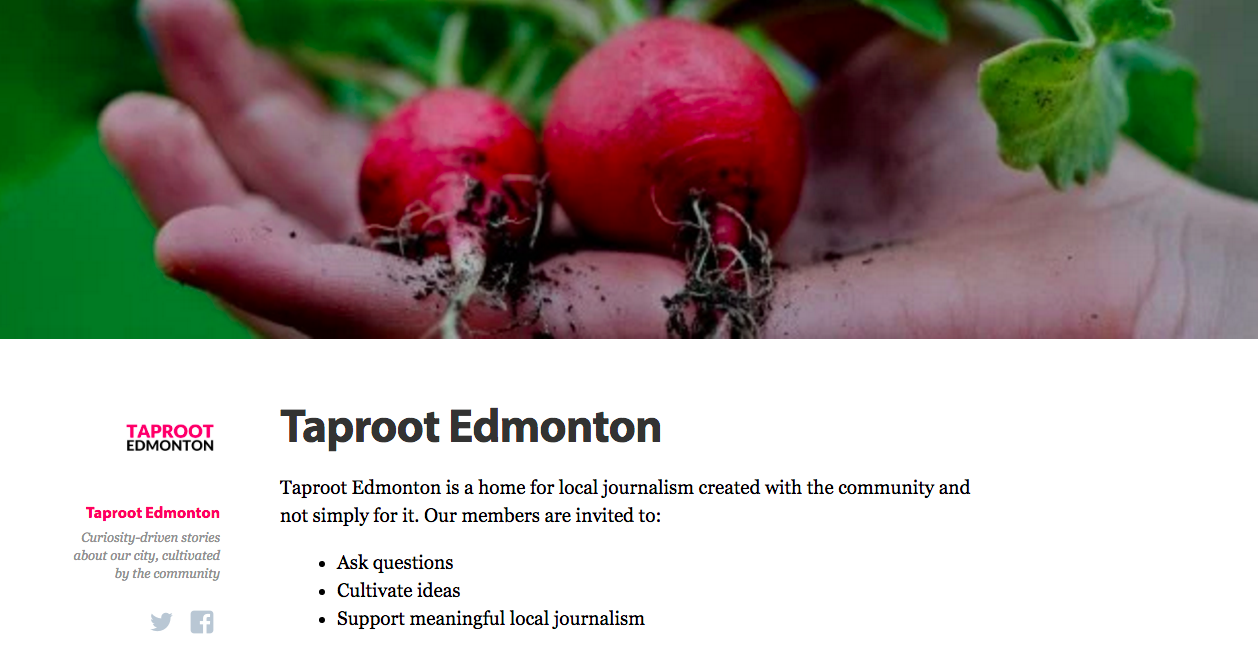This story was funded by the J-Source Patreon campaign.
By Trish Audette-Longo
Taproot Edmonton’s very first story wouldn’t normally crack a newspaper’s front page or the 6 o’clock news.
Posted online in September, “South Edmonton’s surprising deer paradise” was written by freelance journalist Mel Priestley and offers a detailed account of how deer live in the midst of suburbs, industry and shopping malls. It’s a tale of climate change and human-animal co-habitation in the midst of urban sprawl.
As Taproot Edmonton co-founder and former Edmonton Journal editor Karen Unland points out, it also has no news “hook.” It was driven instead by the curiosity of members of the new Taproot community.
Launched in May, Taproot Edmonton offers one answer to how people living in Alberta’s capital might continue to see their local stories following deep Postmedia cuts earlier this year and the merger of the newsrooms of the city’s two leading daily newspapers. It also provides a welcome source of freelance employment for journalists in Edmonton, a mid-sized Canadian media market.
The tale of Edmonton’s “deer paradise” is a calling card for the kinds of local stories Taproot Edmonton’s co-founders, Unland and Mack Male, want to tell: answers to questions “planted” by community members and developed by paid freelancers.
“This enterprise really depends on active engagement and local stories,” Unland said.
Taproot Edmonton flips the paywall model by asking subscribers to pay $100 annually to be part of the story-generating community rather than charging audiences to access digital content. The “story garden,” and members’ ability to contribute to its forum by commenting or voting on their level of curiosity about ideas on a scale of 0-5, remains behind a paywall. The two articles posted so far— Priestley’s story and a story about reconciliation in Edmonton—are free to circulate online.
The best part? They then get to pay freelancers to work, a welcome source of employment for journalists in Edmonton.
“We’re trying to create something that’s hearty and tastes good and is good for you,” Unland said, explaining “Taproot” as the name for the new company and its guiding ethos.
“We’re not in the click-bait business, we’re not trying to be sensational,” she said. “We’re trying to write something that’s worth reading.”
In January, Postmedia laid off 35 people across Edmonton’s two main newspapers, the Edmonton Journal and the Edmonton Sun. The job cuts in Edmonton were part of a broader cost-cutting measure that saw 90 people lose their jobs on the same day across the nation-wide newspaper chain.
Or, as Unland—who had left the Journal before the layoffs—put it, “We have to do something—what are we going to do?”
Unland and Male, who is a well-known author of a blog about Edmonton, an entrepreneur and a software developer, saw a gap that could be filled.
Taproot Edmonton would publish stories based on what subscribed community members want to see. After people plant stories, others in the Taproot community contribute to a conversation about the proposal. As interest within the “story garden” grows, Unland and Male assign the story to one of the seven Taproot members who have also indicated they want to produce stories.
Producers are paid $50 to research proposed stories, and determine whether a story is feasible to produce. They receive $450 to complete the story. (They also must pay the Taproot membership fee.)
Taproot has about 50 paying members, nearly half of whom actively contribute to the story garden. Unland said they are curious about Edmonton and, particularly, urban affairs.
Among a list of story ideas recently posted to Taproot’s garden, members ask about a business slowdown on a street in the city’s core, “How do our city council members prepare for big votes?” and, “Why does it seem like Edmonton is horrible at traffic light timings?”
Priestley refers to Taproot as “this little beacon of hope,” where quality is more important than advertising and clicks. (There is no advertising on the Taproot website.)
She estimates she spent two days refining a “discovery document” for her first Taproot story and a month reporting, writing and revising the final piece.
Freelancing is a part-time job for Priestley, who graduated from the University of Alberta’s honours English program in 2007 and now works full-time in finance, administering pension and retirement plans. She said she was always wary of the unpaid or low-paid journalism internship. Earlier this year, she interviewed journalism students who had “dim hopes” for the future for a story published on the heels of the Postmedia lay-offs.
“I was pretty disenfranchised myself with how things were going,” she said.
With two stories published online since September, Taproot Edmonton aims to publish stories on a weekly schedule in the future.
“Limiting factors on how often we can publish is partly our own time, and partly how much money we have, right? Because writers get paid right away,” Unland said.
To meet their goals, Unland said Taproot Edmonton’s paid membership would need to multiply significantly. They want to have as many subscribers as local newspapers have had.
There may be other funding models to pursue, too, such as corporate support, live events or grant support, now that Taproot can demonstrate what its stories would look like.
“Our larger plan is to make a mission that works here that can be transplanted to other cities,” Unland said.
This said, Unland describes the conditions in Edmonton, a city of 900,000 people, as ripe for a new kind of local media model: “Edmonton is maybe the right size of city for this, and it might have the right … amount of people interested in local media because there is still local media here, but we also know that people are worried about whether their local media outlets are going to survive,”she said.
Trish Audette-Longo is a PhD candidate in the Department of Communication Studies at Concordia University in Montreal.
Disclosure: Trish Audette-Longo has known Taproot’s co-founder, Karen Unland, for many years, as she was her assignment editor and later online editor at the Edmonton Journal. Audette-Longo is neither affiliated with, nor a paying subscriber to, Taproot Edmonton, and both she and Unland left the Journal before the 2016 layoffs.
Trish Audette-Longo is an assistant professor in the School of Journalism and Communication at Carleton University. Her research focuses on start-up journalism, digital journalism and coverage of climate change and fossil fuels. She is also the editor-designate of the journalism studies journal Facts and Frictions / Faits et Frictions, which is published by J-Schools Canada.


